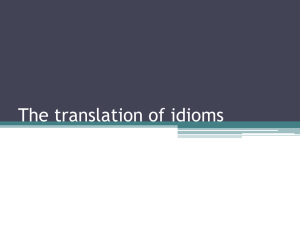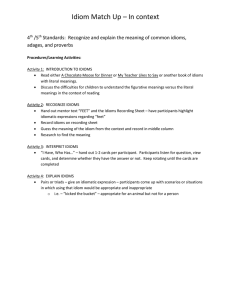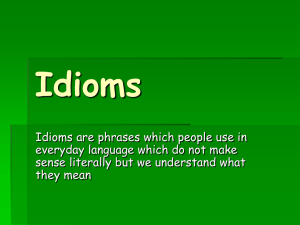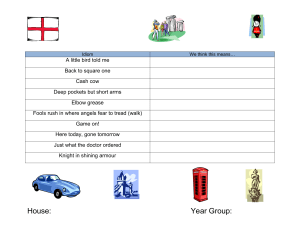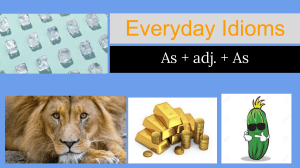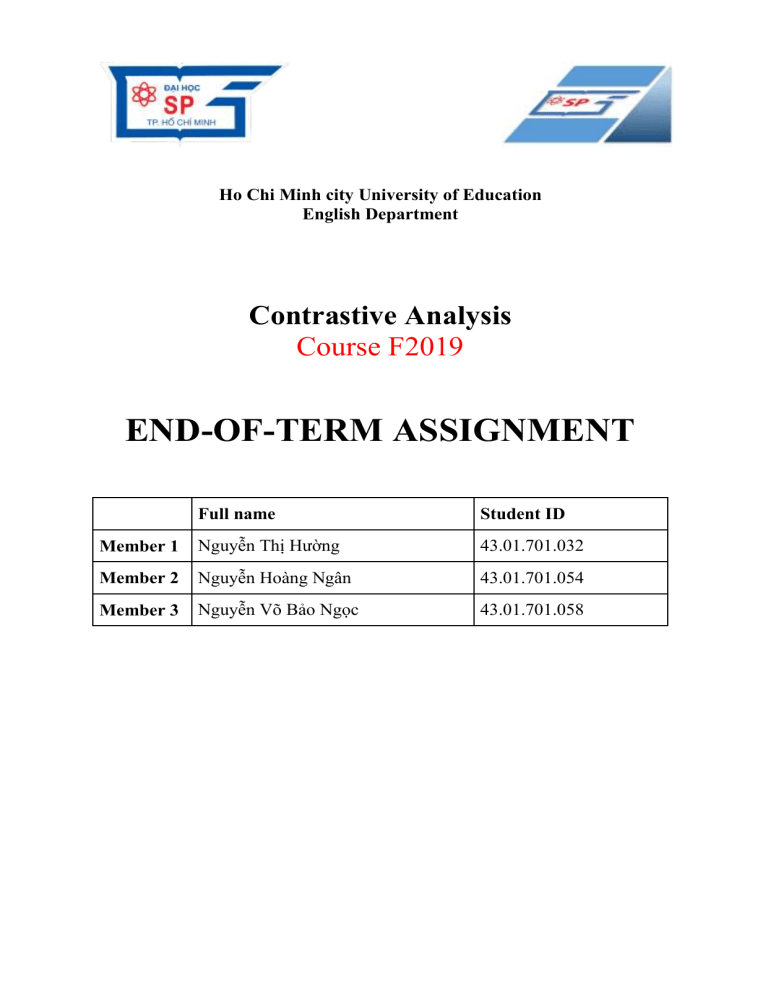
Ho Chi Minh city University of Education English Department Contrastive Analysis Course F2019 END-OF-TERM ASSIGNMENT Full name Student ID Member 1 Nguyễn Thị Hường 43.01.701.032 Member 2 Nguyễn Hoàng Ngân 43.01.701.054 Member 3 Nguyễn Võ Bảo Ngọc 43.01.701.058 Declaration We certify that the attached material is our original work. No other person’s work or ideas have been used without acknowledgement. Except where we have clearly stated that we have used some of this material elsewhere, we have not presented this for assessment in another course or unit at this or any other institution. We have retained a copy of this assignment. Nguyễn Thị Hường Nguyễn Hoàng Ngân Nguyễn Võ Bảo Ngọc A Contrastive Analysis of Idioms about Colors in English and Vietnamese Nguyen Thi Huong, Nguyen Hoang Ngan, Nguyen Vo Bao Ngoc Ho Chi Minh City University of Education Abstract It is idioms that have always considered a crucial part of the acquisition of the target language since they are meaningful expressions in everyday conversation. Idioms in general and idioms of color in specific have been recognized from many perspectives. From Stunžaitė’s ascription, it is far essentially vital to consciousness on the structural category of idioms (Stunžaitė, 2015). This analysis, however, does not put an emphasis on locating typical syntax features of idioms. It is not only because finding a deep structure that every language has in common is supposed to be impossible, but also idioms are expressions whose meaning cannot be derived from the structure, thence their grammar patterns have to be considered differently from ordinary sentences. This paper, instead, focuses on comparing and contrasting the most emblematic semantic features of color idioms in respect of optimism and pessimism as well as comparative idiomatic expressions of English and Vietnamese. Hopefully, this research will be able to contribute to educational improvement. Key words: color, idioms, comparison, semantic features, positive, negative, Vietnamese, English. 1. Introduction Idioms have always been an emblematic element of a specific dialect, which represents its people’s conception and culture. Learning a foreign language cannot be reckoned to be successful if the learners are not aware of idioms whose meaning is expressed in a unique way. Idioms account for a large proportion of the diversity in a language as they are cultural traits. Nonetheless, do all English idioms related to color have an equivalent one in Vietnamese? This contrast will dig deep into the general and specific aspects of idioms about colors in English and Vietnamese. Each color embodies power and symbol which are interpreted differently in different cultures. Red, for instance, is a symbol of love or danger in European countries, but in Asian areas such as Vietnam, red presents prosperity. Yet when idioms denoting colors, there are not only differences but also similarities discovered in Vietnamese and in English idiom. Therefore, in this study, it is believed that color idioms in English and Vietnamese hold syntactic and semantic distinctions. As a consequence, this research paper will give an answer to these two questions: 1. What are the similarities and differences between Vietnamese and English idioms connected to colors in terms of semantic features, particularly in the two aspects: positive and negative meanings? 2. How identical and discrete are idioms comparing colors in English and Vietnamese? To expound, the analysis first provides an overview of concepts/ subjects based on contrastive analysis including definition and characteristics of idioms. Next, the methodologies are presented in three aspects as well: designing steps/ ways to collect data, data sources and finally data presentation and analysis. From these methods, the contrast comprises each domain, ranging from describing aspects in two languages to comparing them in the direction of interpretation. Finally, researchers draw a conclusion about answering questions given in the research questions and consider the pedagogical implications of studying color idioms in linguistic approaches. 2. Literature Review 2.1. Definition of idiom Although many linguists have provided different notions of idiom, the definition from Oxford Learner’s Dictionary is claimed to be the most trusted and it also categorizes the notion of idiomaticity in the clearest way. In Oxford Learner’s Dictionary, idiom has been defined as “a group of words whose meaning is different from the meanings of the individual words” (Oxford Learner’s Dictionary, 2000) In this sense, an idiom cannot be understood by translating word-by-word, but it has to be taken as a complete phrase. Readers or listeners must have a certain knowledge of culture and tradition of the country where that idiom comes from in order to comprehend its meaning as Langlotz (2006) notes in his book “(…) idioms are peculiar linguistic constructions that have raised many eyebrows in linguistics and often confuse newcomers to a language” (Langlotz 2006:1). According to Strassler, many qualified dictionaries such as Barnhart et al. (1961), Garmonsway (1969), Hanks (1971), Hill (1958), Hornby (1963), Longman (1978), Macdonald (1971), Onions (1956), Sykes (1976), Urdang et al. (1968), Watson (1968), Webster (1961), etc. have defined idiom as this sense (Strassler, 1982). Furthermore, many other leading linguists have a similar approach to categories of idiomatic phrases. Dating back to 1939, Willey proposed a definition for the term idiom which may be the broadest one: “(…) idiom or idiomatic phrase (...) is a phrase the meaning of which cannot be deduced from its component parts.” (Willey 1939: 221). To clear out his point, Willey provides some examples. He considers to bring about an idiom since bring means to come to a place with somebody/something (Oxford Learner’s Dictionary, 2000) and about means a little more or less than; a little before or after (Oxford Learner’s Dictionary, 2000) but the whole phrase means accomplish while to get to the city is not an idiom because its meaning is composite from the word get, to and city. Several years later, Hockett also came up with a definition of an idiom. He argues that “(…) any grammatical form the meaning of which is not deducible from its structure (…) is an idiom.” (Hockett, 1958). Concerning this statement, any language element that its meaning cannot be understood from its structure or included words is an idiom, which means not only morphemes-the smallest unit of language but also a sentence, for example, “What’s up?” can be an idiom since the former has no structure for us to comprehend its meaning and the latter’s meaning is completely different from the way we normally understand that structure. Unlike Willey, Hockett narrows down the sense of idiom by stating “Any Y, in an occurrence in which it is not a constituent of a larger Y, is an idiom.” (Hockett, 1958). In other words, any lexeme that is a part of a phrase or a compound word may not be regarded as an idiom. For example, the word white is itself an idiom when occurring in this sentence This house is white but not in the noun White-house since it is a complement of this noun. Sharing a similar idea, Weinreich conventionally defines idiom as "a complex expression whose meaning cannot be derived from the meanings of its elements" (Weinreich 1969: 26). On top of that, he adds an additional condition for a phrase to be called an idiom “(...)phraseological unit that involves at least two polysemous constituents, and in which there is a reciprocal contextual selection of subsenses, will be called an idiom" (Weinreich 1969: 42). Weinreich categorizes idioms as multiword units such as a phrase or a sentence instead of morpheme like Willey and Hockett, which has two or more complements that have more than one meaning or polysemous and its meaning as a whole must be understood based on the context instead of its literal meaning. Unlike Hockett who considers morphemes as idioms, Makkai, Katz, and Postal take an expression as an idiom only when it contains two or more words. In the book The Semantic Interpretation of Idioms and Sentences Containing Them, Katz and Postal state “The characterization of an idiom as any concatenation of two or more morphemes whose compound meaning is not compositionally derived from the meanings of the concatenated morphemes.” (Katz/Postal, 1963). In her book Idioms: Description, Comprehension, Acquisition and Pedagogy, Dilin Liu compares the two definitions of Makkai and Katz and Postal. According to Dilin Liu, although Makkai, Katz, and Postal all agree on the fact that an idiom’s meaning cannot be derived from its constituent parts, they disagree on the morphology of an idiom. Although all three linguists categorize phrases with at least two words as idioms, Makkai reckons that only multiword expression with two or more free morphemes may be considered as idioms. In other words, words with one free and one bound morpheme cannot be called an idiom since its meaning can be derived from the bound morpheme which is contrary to the aforementioned definition. 2.2. Features of idioms 2.2.1. Syntactic features Based on the aforementioned framework, there is an agreement that almost all idioms are fixed expressions. O’Grady (1998) postulates that although idioms do not need to form constituents they have to follow an important grammatical constraint. Some views divide idioms into two main types - the first type is, according to Fraster (1970), those that are not capable of undergoing the smallest changes in grammar at all, and the second type is those which are able to do. From another viewpoint, Erlbaum (1995) states that Wasow, Sag, and Numberg (1983) and Gazdar, Klein, Pullum, and Sag (1985) shared the same idea about the types of idioms. They classify idioms into two categories: one that could not be semantically analyzed and the other to which compositional semantics applies. For the first type of idioms, Grady introduces the term “surface structure constituents” as the literal expression and claims this type of idiomatic expressions cannot be understood by separating words in a phrase. For instance, the idiom “let the cat out of the bag” means to allow the secret to be known. However, when swapping the positions of the word “cat” to “dog”, the listener will not consider the sentence as an idiom. In this case, this sentence is understood in its literal meaning. Another example that can be taken is the idiom “Giving the cold shoulder”, which means you are ignoring someone. Nevertheless, it seems to be ridiculous if we change the form of the idiom from active to passive voice by saying “The cold shoulder is being given”. Additionally, Nunberg et al. (1994, p.500ff), Fellboun (1993, p.273) and Pulman (1993, p.252) agreed that parts of idioms can take non-idiomatic modifiers. Lutzeier (1995) define these idioms as the ones that are semantically unanalyzable. For example, the idiom “kick the bucket” means to die. It is clear the meaning of this idiom cannot be deduced by combining the meanings of the single word. Therefore, the analysis of separately-taken constituent parts of idioms may be impossible. However, as Chafe (1968) claimed, “some idioms are syntactically ill-formed” (as cited in Strässler, 1982, p. 35), which means some idioms do not conform grammatical structures. Similarly, Croft and Cruse (2004) state that idioms challenge the separability of syntactic levels, since they're pieces of syntax but, like words, they cannot be described in a levelimpartial way, including phonology and syntax. Some examples support this statement are “go banana” or “till kingdom come”. 2.2.2. Semantic features a) What is Semantics? Hurford, Heasley and Smith (2014) have investigated semantics and commented on its vagueness and abstract. Despite saying it is hard to give a clear conclusion about semantics, they do present an intelligible definition of the term that semantics is related to the study of meaning in language. To Minh Thanh shares the same idea when she states “Semantics is a branch of linguistics which deals with meaning.” (To Minh Thanh, 2007, p.9). In her viewpoint, it is syntax which deals with grammar, semantics and pragmatics which connect to meaning. Those are the three main branches in linguistics. In addition to her analysis, semantics has a connection to denotation (literal meaning) and connotation (implicit meaning) (To Minh Thanh, 2007, p.30). Idioms are hence the connotative meaning. Another point of view in defining semantics is from the linguist John Lyons. His book separates semantic features into two terms: linguistic semantics and non-linguistic semantics. The first one, in other words, is obviously the study based on word meaning. Although his focus is not distinguishable from the two formers, the branches of semantics are sorted into philosophical semantics, psychological semantics, anthropological semantics, logical semantics, linguistic semantics, and so on (Lyons, 1995, p.6). A more ancient study from Wierzbicka (1988) which is the combination between the second and the third given viewpoint, does not solely state the domains of semantics include lexical semantics, grammatical semantics and logical semantics. Wierzbicka contrasts semantics with linguistic pragmatics, which is the study deals with conventionalized meaning. To expand this idea, To Minh Thanh (2007) gives her example: (1) A: ‘Would you like a piece of cake?’ B: ‘I’m on a diet.’ From (1), the semantic meaning of B’s utterance can be worked out as “I do not want to gain weight by consuming sweet food.” and the pragmatic meaning of it is B is giving refusal or “I don’t want any of them.” Therefore, To Minh Thanh (2007) compares that semantic meaning can be interpreted as context-free whereas pragmatic meaning is concluded as context-dependent. b) Idiomatic expression in semantics Since idioms are multi-word phrases, they are cannot be comprehended word-by-word. Only by clinching to contexts is the meaning figured out the speaker's meaning. As claimed by Kovecses and Szabc (1996), there are two views from semantical analyzing idiom, the first is in a traditional way and the last is a cognitivist view. According to them, idioms are traditionally referred to as a fact related to lexical items which means they are context-free. Idioms are supposed to similar to words that have reliable syntactic features and convey a special meaning associated with their constituents. Followed the previous view, in cognitive interpretation, idioms are seen as products of the conceptual system, in other words, they are context-dependent. Since an idiom is not simply a matter of language, it is an utterance carrying a meaning that must be related to special knowledge to make sense of. On the contrary, Hurford, Heasley and Smith (2014) do not investigate idiomatic expression traditionally, they emphasize their focus on the second. They note that meaning from idioms is not separated from the context in which the utterance is used. Take an example in the idiom “black sheep”. The literal sense is the sheep has black fur and the idiomatic sense is worked out as the odd or bad member of the group. c) Conclusion In summary, though there are many conceptions about idiom, the main focus is on the fixed expression built by multiple words, which lead to a continuum of syntax and semantics. However, it is difficult to analyze idiomatic expression syntactically for syntax is constrained and not diverse. Thus, semantic is a reliable base to interpret idioms. 3. Methodology 3.1. Research design It can be noticed that research on syntactic features for idioms in general and idioms related color, in particular, is almost impossible. This research mainly draws attention to comparative analysis in terms of semantics. To clarify its distinctions between two languages, the research first describes information about color idiomatic expressions in both positive and negative meanings, as well as analyze and depict comparative-color idioms. The information should be described in both languages: English and Vietnamese. Then, based on the information aforementioned, the similarities and differences of color idioms found in the two languages are contrasted. 3.2. Source of data Secondary data is applied in this research. The collected data are retrieved from documents and social experiences. 3.3. Data presentation and analysis 3.3.1. Data presentation technique: Tables To be specific, in the description of positive and negative expressions in Vietnamese and English, tables are separated into three notions as the following table: Color Idioms English Meaning Vietnamese Table 1 Furthermore, there are tables describing comparative color idioms between two languages: Color Comparative color idioms in Comparative color idioms in English Vietnamese English Vietnamese Table 2 3.3.2. Data analysis technique This research paper follows deductive analysis which means after describe data collection, contrast is conducted. 4. Contrastive analysis According to the aforementioned framework, locating the general structure of idiomatic expressions is unachievable. Thus, color idioms will be described in terms of semantic features. To clarify, Stunžaitė (2015) has investigated the occurrence of colors appeared in English idioms which is shown in the following table: Color Number of occurrences Black 17 White 17 Red 20 Green 7 Yellow 4 Blue 23 Brown 3 Orange 0 Pink 5 Purple 3 Grey 1 It is clear that there are five colors that dominate in the highest frequency namely black, white, red, green and blue. As a result, these five colors are selected as a general reference system for positive and negative meaning analysis as well as to contrast comparative idioms in English and Vietnamese. 4.1. Semantic features of color idiomatic expressions with positive and negative meanings In this section, color idioms are described in the platform of their positive and negative sense in English. 4.1.1. Color idioms with positive and negative meanings in English a) Positive meanings color idiomatic expressions Color Idioms English Vietnamese Meaning - To be in the black - To be successful or profitable. - Black tie event/affair - A formal event where male guests wear black bow ties with tuxedos or Black Đen dinner jackets. - In black and white - In writing or in print, and regarded as more reliable, credible, or formal than by word of mouth. - A white lie - A ‘little’ or ‘harmless’ lie told in order to be polite and avoid hurting White Trắng someone’s feelings, or do something that is not seriously wrong. - To be out of the red Red Đỏ - To be out of debt. - Something new and exciting, - Red hot creating much demand. - Red-letter day - A day that is memorable because of some important events. - To look through rose- - To see things in an overly flattering coloured/tinted or over-optimistic light. spectacles/glasses - Paint the town red - To go out and have a really good time at a party. - Roll out the red carpet - To greet a person with great respect, and give them a big, warm welcome. - Red-carpet treatment - Special or royal treatment, and be received with a big, warm welcome. - A blue-eyed boy - A critical description of a boy or young man who is always picked for special favours by someone in a Blue Xanh position of higher authority. da trời - Someone from a noble, aristocratic - Blue blood or wealthy family. - Blue ribbon - To be of superior quality or distinction, the best of a group. - Green Xanh lá cây Green thumb/green - Someone with a talent for gardening, finger having the ability to make plants grow. - Give someone the green - To give permission to go ahead with light / get the green light something. b) Negative meanings color idiomatic expressions Colors Idioms Meaning English Vietnamese - Black and blue Black Đen - Something that is badly bruised. - To exclude or ostracise someone socially, - Blackball someone reject them. - Pot calling the - To hypocritically criticises or accuses kettle black/ pot someone else is as guilty as the person he or kettle black - To she criticises or accuses. blackmail - To extort or take money from someone by someone using their secrets against them and threatening to reveal it to others. - To be in someone’s - To be in disgrace or in disfavour with black books someone. - Black sheep - A person who is the ‘odd one out’ of a group, and doesn’t fit in with others around them/ someone who is a disgrace or embarrassment to their group. - Pitch black - Somewhere that is very dark, and you are unable to see anything. - A black day - A day that marks a sad or unfortunate event. - As white as a sheet - To be in a state of great fear or anxiety. - Raise a white flag - To accept defeat and surrenders to the other party. - White elephant White Trắng - A useless possession, something that is of no use. - White as a ghost - To be very pale because of pain, fear, shock or illness. - To whitewash - To cover up or gloss over faults or something wrongdoings. - To be shown the - To be dismissed from a job. red card - To be in the red - To have an overdraft, be in debt to your bank, or owe an institution some money. Red Đỏ - A red flag - A signal that something is not working properly or correctly. - An unimportant matter that misleads - Red herring everyone and draws attention away from the main subject. - To become embarrassed. - Red in the face - Red tape Bureaucratic delay, or excessive formalities, and attention to rules and regulations, often resulting in injustice to the ordinary citizen. - To recognise approaching danger. - To see the red light - To feel blue - To feel depressed or discontented. - Blue in the face - To try really hard to win someone’s agreement, but usually end unsuccessfully. Blue Xanh da trời - Once in a blue - To be extremely rare. moon - A bolt from the - An unexpected bad news. blue - Blue pencil - To censor something, or limit the information that is shared. - To be green - To be immature, or inexperienced. - To be green with - To be extremely jealous, full of envy. Green Xanh cây lá envy - Grass is (always) - Said about people who never seem happy greener on the other with what they have and always think they side (of the fence) could be happier in a different place or situation. 4.1.2. Color idioms with positive and negative meanings in Vietnamese Although there are equivalent words for blue and green in Vietnamese, there is no clear distinction between blue and green in Vietnamese idioms. Instead, they are regarded as “xanh”. a) Positive meanings color idiomatic expressions Color Idioms Meaning English Vietnamese Black Đen - Giấy trắng mực - In black and white; in written form; in đen writing. - Ăn trắng mặc - To live in clover/in luxury/on the fat of the trơn land, to live like a lord, to live like fighting cocks; to live in regal splendour. White Trắng - Gạo trắng nước - Used to describe a countryside with trong favourable climate and fertile soil. - Trong trắng - Clean; pure; immaculate; untarnished; unblemished. Red Đỏ (son) - Đỏ da thắm thịt - To be glowing with health. - Số đỏ/ vận đỏ - A good luck; good fortune; windfall; godsend. - Lòng son dạ sắt - To be unshakably loyal, faithful. - Lầu son gác tía - A luxury place where feudalists from higher class lived. - Bật đèn xanh - To give somebody the go-ahead; to give somebody the okay to do something. Blue - Đầu xanh tuổi - Youth, youthfulness. Xanh trẻ/ Ngày xanh, xuân xanh Green - Lọt vào mắt - To meet all the high demands of someone. xanh b) Negative meanings color idiomatic expressions Color Idioms Meaning English Vietnamese Black Đen - Đen tối - To be in big troubles that cannot find the way out/ to have some indecent thoughts in mind. - Cơn đen vận - To encounter lots of difficulties in life. túng - Dân ngu khu đen - Poor workers with no rights and do not have - Đổi trắng thay a voice. đen - To be double-tongued; treacherous; false- - Lập lờ đánh lận hearted. con đen - To tell lies or to cheat by using some shifty - Cừu đen tricks. - The one who has the most bad luck in a family. - Nói trắng ra - To call a spade a spade; not to put too fine a point on it; to talk turkey; not to mince matters; not to mince one's words. White Trắng - Lo bò trắng răng - To unnecessary worry. - Hàng trắng - Trắng tay - Cocaine, drugs. - Trắng bệch - To be cleared out, without a penny, penniless. - To be very pale. - Đỏ mặt tía tai - To be purple with rage. - Khỉ chê khỉ đỏ - To unreasonably criticize someone without Red Đỏ đít self - reflection. - Mắt xanh mỏ đỏ - Used to describe someone who wears tons of - Gần rừng lại makeup không biết khỉ đỏ - To stay near bad guys without realising their đít bad personality. - Báo động đỏ - An urgent alert. - Xanh xao vàng - To be very pale. Blue vọt Xanh - Đau thấu trời - To get terribly hurt. xanh Green - Còn non và xanh - To be inexperienced. 4.1.3. Comparative idiomatic expressions in English and Vietnamese Color English Vietnamese Black Đen Comparative color idioms in Comparative color English idioms in Vietnamese - As black as jet - Đen như mõm chó - Black as night - Đen như than - Black as a skillet - Đen như bồ hóng - As black as a sweep - Đen như cột nhà cháy - As black as coal/ as black as the ace - Đen như quạ of spades/ as black as pitch - Đen như mực - As black as a stack of black cats - Đen như củ tam thất - Đen như tượng đồng - Đen như cuốc - Đen như lòng chảo White Trắng - As white as snow - Trắng như bông - To be as white as a sheet - Trắng như tuyết - White as ghost - Trắng như mây - Trắng như ngà - Trắng như trứng gà bóc Red - As red as a cherry - Đỏ như son - As red as a poppy - Đỏ như gấc - As red as a rose - Đỏ như son - As red as a ruby - Đỏ như đồng hun - As red as blood - Đỏ như máu - Mắt đỏ như mắt cá chày Đỏ - Mắt đỏ như miếng tiết - Mặt đỏ như gấc - Mặt đỏ như vang - Mặt đỏ như quan công - Mặt đỏ như đồng tụ - Xanh như tàu lá chuối Blue Xanh Green NOT EXIST - Xanh như lá, bạc như vôi - Xanh như chàm 4.2. Contrastive analysis From the collected data, the similarities and differences between English and Vietnamese color idioms have been withdrawn. 4.2.1. Contrast in respect of optimism and pessimism a) Similarities Both English and Vietnamese have idioms with positive and negative meanings. “Black” accounts for the largest number of idioms relating to it but most of them carry negative meaning and it is due to the cultural conception of both areas. Additionally, there are also many equivalent pairs of color idioms in English and Vietnamese, for example, “give someone the green light / get the green light” in English is equivalent to “bật đèn xanh” in Vietnamese, “to see the red light” is equal to “bật đèn đỏ”, the phrase “in black and white” is equivalent to “giấy trắng mực đen”, “black market” is equal to “chợ đen”, etc. b) Differences In English, there are blue and green idioms, but in Vietnamese, there is a thin line between these two colors, instead, they are combined into “xanh” without declining its diversity. As a result, these idioms in Vietnamese usually cause lots of confusion which is also one of their unique beauty. Moreover, there are more red idioms in English than those in Vietnamese. In English, that number is 20 while in Vietnamese, it is 15. There are some cases where idioms in English and Vietnamese are equivalent if it is understood word-by-word. However, when they are taken as a whole, their senses are completely different. For instance, the word “white” in “white goods” means “trắng” and “goods” means “hàng”, so it is “hàng trắng” in Vietnamese which refers to drug or narcotic and this meaning is distinguishable from what “white goods” means in English which is electronic household appliances. Another example is “to be in the black” means “lucky” in English, but when “black” is translated into Vietnamese, it is “đen” which means “bad luck”. On the contrary, some idioms in English may convey the same idea in Vietnamese when they are interpreted as a whole but their word expressions are not equivalent. “In black and white” is a vivid example. This phrase means “in writing or in print and regarded as more reliable, credible, or formal than by word of mouth” which is also the meaning of “giấy trắng mực đen”. But when “in black and white” is taken word by word, it is “trong đen và trắng” which is not the same as “giấy trắng mực đen”. Some English color idiomatic expressions share the same meaning as the ones in Vietnamese. However, those Vietnamese idioms are not color idioms. For instance, we have an English idiom “grass is always greener on the other side” and its equal idiom in Vietnamese is “đứng núi này trông núi nọ”. There are lots more examples to be considered which are “red herring” in English has the same meaning to “đánh trống lảng” in Vietnamese, “red hot” means “nóng hổi”, “a blue-eyed boy” means “con ông cháu cha”, “blackball someone” means “tẩy chay ai đó”, “pot calling the kettle black/ pot kettle black” means “49 gặp 50” or “kẻ cắp gặp bà già”, “as white as a sheet” means “tái mét” and “white as a ghost” also means “tái mét”. 4.2.2 Contrast in terms of comparative idiomatic expressions a) Similarities In this category, idioms with color black also dominate between English and Vietnamese. Most of the black-color idioms that have “as...as” structure in English and “như” in Vietnamese both contain a simile. What is more, these idioms are used for distinct purposes and not mutually. For example, in Vietnamese, “đen như cột nhà cháy” can only be used to criticize or disparage someone or something while “đen như quạ” is used to complain about your bad luck. Some pairs of idioms are completely equivalent in English and Vietnamese in terms of word used and meaning. For example, “as white as snow” means “trắng như tuyết” and “as red as blood” means “đỏ như máu”. There are few or no comparative idiomatic expressions relating to blue and green in both English and Vietnamese. b) Differences The significant distinction of comparative expressions between English and Vietnamese is the typical phrase structure. In Vietnamese, it is color + như + NP whilst in English, the structure is as + color + as + NP. Besides, idioms in English and Vietnamese may have the same meaning but are conveyed by different colors. For instance, both “as white as a sheet” and “xanh như tàu lá chuối” refer to be pale because of sickness but “xanh như tàu lá chuối” relates to color green. Last but not least, Vietnamese has a larger number of red idioms than English and most of them are used to describe different facial expressions. 5. Conclusion In this part, we would like to reach some conclusions on syntactic and semantic features of English and Vietnamese color idioms. From this aspect, color idiomatic expressions in both languages have a dominated number of differences. From the aspects of negative and positive meanings, it can be observed that idioms using the color black in both English and Vietnamese account for the highest frequency in occurrences, and most of the black color idioms express negative meanings. Besides, some color idiomatic expressions in English share the meanings in common compared to those in Vietnamese. For example, the idiom “give someone the greenlight/ get the green light” in English is equal to the idiom “bật đèn xanh” in Vietnamese. However, there are still some major differences, which are “green” and “blue” in English are regarded as only “xanh” in Vietnamese. Additionally, there are some color idiomatic expressions in English and Vietnamese which are supposed to be similar, but when it comes to idioms, they are completely different. A good example of this part could be “white goods” in comparison with “hàng trắng”. The word “goods” in English means “hàng” in Vietnamese, and they are both white color idioms. Nonetheless, “white goods” is an English idiom refers to large electrical goods for the house, such as cookers and washing machines, while “hàng trắng” in Vietnamese is drugs or cocaine. If the chosen frame of reference is comparative idiomatic expressions, color black idioms are still the majority. Besides, there are many perfect equivalent pairs in Vietnamese and English such as “as white as snow” and “trắng như tuyết” but there are also some underlying differences when contrasting comparative idiomatic expressions in English and Vietnamese. 6. Pedagogical Implication Idioms have a high frequency of occurrence and contribute a huge part in the diversity in both Vietnam and English-speaking countries. Consequently, a deep understanding of idioms especially color idioms must be taken into consideration by educators and scholars. To begin with, learners should take active steps in researching color idioms since it can help them communicate naturally and efficiently in the target language. Besides, idioms can only be understood with a certain knowledge of culture and tradition so learning about idioms can provide students with a profound understanding of many other aspects of that country instead of language only. In addition, educators need to continuously widen their knowledge of idioms in order to facilitate students in enriching their knowledge of not only language but also culture and tradition. On top of that, teachers also need to conduct many activities with real-life situations for students to practice using idioms in the right context and understand more about the idioms’ social and historical background. References Croft, W., & Cruse, D. (2004). Cognitive linguistics. Cambridge: Cambridge University Press. Hockett, Charles F. A Course in Modern Linguistics. Macmillan, 1970. Hurford, J. R., Heasley, B., & Smith, M. B. (2014). Semantics: a coursebook. Cambridge: Cambridge University Press. Katz, J., & Postal, P. (1963).The semantic interpretation of idioms and sentences containing them. MIT Research Laboratory of Electronic Quarterly Progress Report. Kövecses, Z., & Szabó, P. (1996). Idioms: A View from Cognitive Semantics. Applied Linguistics, 17(3), 326-355. doi: 10.1093/applin/17.3.326 Langlotz, A. (2003). Idiomatic creativity: A cognitive linguistic model of idiom representation and variation for English idioms. Verlag nicht ermittelbar. Liu, Dilin. Idioms: Description, Comprehension, Acquisition, and Pedagogy. Routledge, 2017. Lutzeier, P. (1995). Martin Everaert/Eric-Jan van der Linden/André Schenk/Rob Schreuder (eds.), Idioms, structural and psychological perspectives. Lyons, J. (1995). Linguistic Semantics: An Introduction. Cambridge University Press. Makkai, A. (1972). Idioms structures in English. O'Grady, W. (1998). The Syntax of Idioms. Natural Language And Linguistics Theory. DOI: 10.1023/A:1005932710202 O'Grady, W. (1998). The Syntax of Idioms. Natural Language and Linguistic Theory, Oxford advanced learner's dictionary of current English. (2000). Oxford University Press. Strassler, J. (1982). Idioms in English: A pragmatic analysis. G. Narr Verl Strässler, J. (1982). Idioms in English: A pragmatic analysis. Tübingen: Narr. Stunžaitė, A. (2015). Manifestation of color idioms in the English, Lithuanian and Russian Languages [Pdf file]. Retrieved from https://vb.vdu.lt/object/elaba:8665125/8665125.pdf To-Minh-Thanh. (2007). English Semantics. TP Ho Chi Minh: NXB Đại học Quốc gia TP Ho Chi Minh. Weinreich, U. (1969). Problems in the analysis of idioms. In J. Puhvel (Ed.), Substance and structure of language (pp. 23-81). Berkley, CA: University of California Press. Wierzbicka, A. (1988). The Semantics of Grammar. Amsterdam: John Benjamins. Willey, N. L. (1939). German Idioms. The https://doi.org/10.1111/j.1540-4781.1939.tb02903.x Modern Language Journal.

